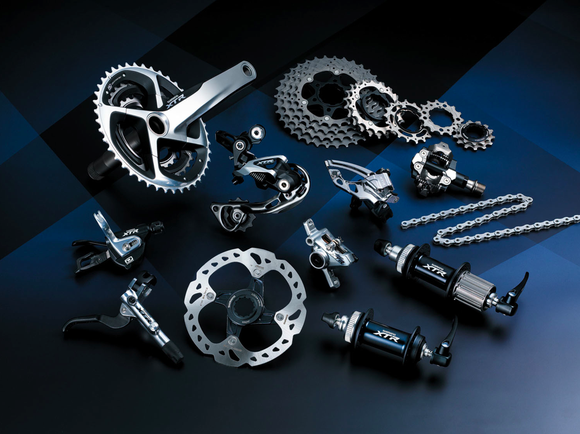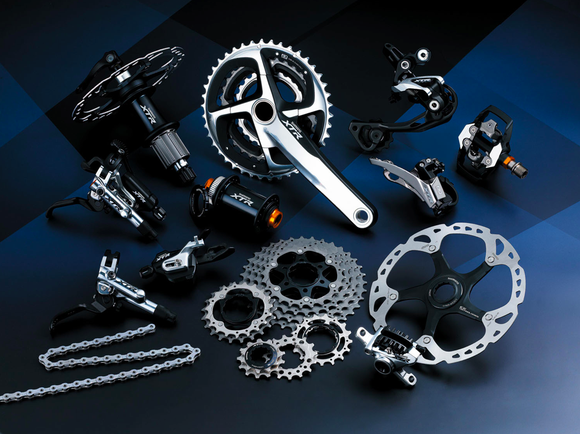
It鈥檚 been nearly a year since Shimano introduced its totally revamped XTR range, the sixth generation of the top-end mountain groupo, and we鈥檝e been riding it hard ever since. Whereas in the past XTR catered mostly to weight-conscious racers, with this iteration Shimano has recognized that the top-tier components appeal to a broad spectrum of users and they鈥檙e now offering it in both a featherweight Race spec and a sturdy-but-still light Trail group.
While derailleurs, shifters, and chain are common between the two groups, riders choose the cranks (two gearing options for Trail, and three for Race), brakes, wheels, and pedals that best meet their needs. This adds a layer of complexity to the purchasing process, but it also means that you can get exactly what you need based on your riding style. For instance, a racer who rides especially rough terrain could get the full Race package but sub the beefier Trail wheels for added durability, or a flatlander who prefers the Trail spec but needs a higher gear ratio could opt for one of the bigger double crank configurations of the Race group. Both groups are relatively light, with the core Race setup weighing in a few hundred grams lighter than the Trail group (though even the Race components aren't the lightest on the market).
For comparison sake, we ordered up both a Race and Trail group and rode them for the past half year, both back to back on the same bike () and side by side on task-appropriate bikes (Race on a Specialized Epic and Trail on a ).
Drivetrain
Following SRAM鈥檚 lead, Shimano went 10 speeds in back on this group, which makes for both a broader range of gear options as well as smaller intervals between each cog. Rear shifting, already smooth and instantaneous in the previous XTR, got even quicker accordingly, but the most noticeable change is in just how even the stroke is. Because of a slightly longer cage design on the rear derailleur, the shifting is light and easy from the bottom of the gear range all the way up to the top. The sleek shifters retain the trigger shift design of past generations, meaning you can downshift with either your thumb or your pointer finger, an option that we absolutely love. Two other niceties we really appreciate: The rear shifter lets you upshift up to three gears at once, and once in the biggest ring, both shifters offer no resistance so you automatically know you鈥檙e at the top of the range.
On the Race side, we went with a 40-28 gearing, while we chose the triple option, 42-32-24, for Trail. Paired with the new 11-36 cassette in back, which gives an even bigger granny gear than previous XTR, we found that both configurations provided crisp, instantaneous shifts. Because of the smaller spacing between the front chainrings, the advantage went to the Trail group, though the differences were negligible. Both setups offered enough gears for most scenarios, with the one caveat being on the 29er, where the bigger wheels meant we sometimes felt over-geared and in the top of the rear cassette range rather in the middle sweet spot. The Trail group again came out on top here because of it鈥檚 slightly bigger range, but we felt that the lack of a double crankset with 29er-appropriate gearing was a bit of a miss (though privately Shimano tells us this is in the works). One thing we appreciated in both Trail and Race groups is Shimano's continued commitment to creating lightweight aluminum cranks, which we think hold up to trail abuse and retain their aesthetics better than the carbon variety.

Brakes
The entire brake system has been redesigned from the ground up, including levers, master cylinders, calipers, rotors, and pads, and in our opinion Shimano got it all nearly perfect. The Race levers are very slightly smaller than the Trail variety and are dimpled for extra grip, and we felt they were slightly more comfortable (though admittedly our hands aren't especially big). Both groups have amazingly simple and clean ergonomics that provide excellent one-finger braking. Race and Trail brakes each have reach adjusters, but the Race setup loses the stroke adjustment (which lets you fine tune the spot in the lever stroke where the pads make contact) in the name of weight savings. Given that the stroke adjustment wasn鈥檛 terribly effective, we鈥檙e not sure it鈥檚 worth the extra weight (40 grams) anyway. Advantage: Race.
On both setups, we ran 160mm rotors front and rear, and we found the stopping power totally confident verging on jolting. It's worth noting that Shimano says their rotors, dubbed Ice Tech because the internal layers of aluminum improve brake grip by apparently remaining cooler than straight-up steel, are integral to the system, and after testing the brakes with non XTR rotors we agree. While stopping felt mushy and anemic with other brands of rotors, it regained it's confidence and bite we reinstalled the Ice Tech hardware. The Trail pads continue the temperature regulation with cooling fins that further dissipate heat, and it's true that even on very long descents (think nine continuous miles of steep single track outside of Salida, Colorado), we never experience any fade with the Trail group.
Also, after switching from the standard resin pads to the optional metallic ones, which provide more force but proved a bit squawkier, we'd say that XTR brakes have more stopping power than pretty much anything else out there. With the metallic pads, the modulation isn't quite as good as a couple of other leading brands we've ridden, but overall the durability, ergonomic comfort, and sheer power make these both our favorite brakes on the market and our favorite part of the entire XTR package.聽
Wheels
Our biggest complaint about XTR wheels in the past was weight, and with the Race group Shimano finally brings the set under 1500 grams. That's still not among the lightest wheels out there (and the Trail group is almost 200 grams heavier), but for dual through-axle UST-ready hoops it's pretty light. Not to put to fine a point on it, but we absolutely love the UST rims, which seated immediately and easily with our WTB test tires in both the Race and Trail iterations. We ran 15mm axles in both groups, which meant that not only was the steering confident and direct in Race and Trail, but it also allowed us to feel the extra stiffness in the Trail group. If you're really going to bang these wheels around, you might want that rigidity and durability, but given the weight-to-cost equation, as well as the fact that both groups held up fine to six months of hard riding, we'd say the edge here goes to the Race wheels.
Pedals
Both the Race and Trail pedals are as secure and easy to use as ever, and they're much improved with noticeably bigger pedaling platforms. Always comfortable, the pedals' additional metal underfoot make for a more confident feel, and we never got sore feet like we do on some smaller offering out there, even in 12-hour races. Both pedals work great, but we found ourselves most impressed with the Trail offering for the bigger-still platform and added grip of the cage. Of course Shimano pedals will never win any weight awards, so ounce-counters will need to look elsewhere.
Bottom Line
After months of hard riding and racing on this gear, it鈥檚 all working as well as when we started. And we鈥檙e comfortable saying that this is not only the finest iteration of the company鈥檚 best mountain bike equipment, but it鈥檚 currently the most consistent, hardwearing componentry that money can buy. Of course that combination of high performance and light weight will cost you, with Race and Trail groups both bumping into the low $2K range, minus wheels or pedals. That's a ton of money, but the consolation is that you're getting the very best available. If you can afford the new XTR group, the upgrade is well worth the cash. And there's even good news on the price front: For those who can't justify the price, much of the performance gains are trickling down to Shimano's new XT line, launching this year, which we've also been riding and will be reviewing in coming weeks.
–Aaron Gulley